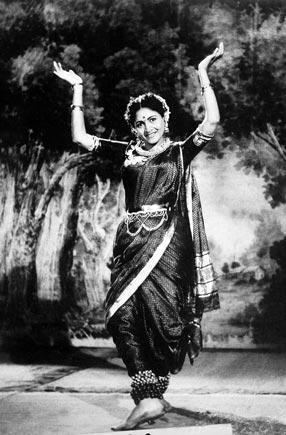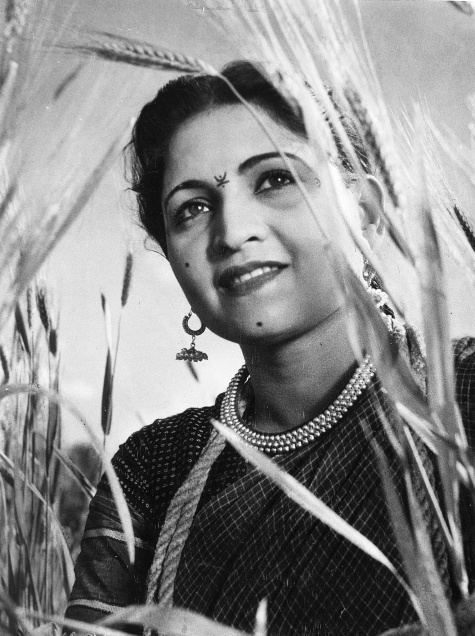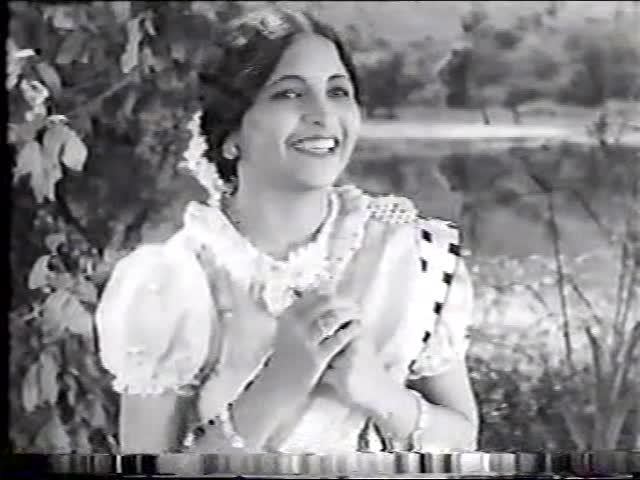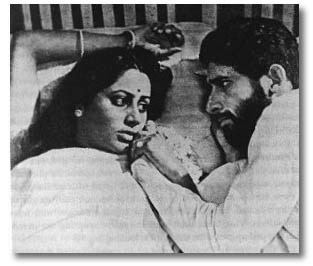Full Name Ratan Salgaokar Children 1 daughter, Rekha Occupation actress Name Hansa Wadkar | Years active 1936–1968 Role Film actress Spouse(s) Jagannath Bandarkar Died August 23, 1971, Mumbai | |
 | ||
Born 1923 Bombay, Maharashtra, British India Movies Bhumika, Sant Sakhu, Lokshahir Ram Joshi, Ramshastri, Apna Paraya Similar People | ||
Aamhi Nighalo Re Bazaara - Marathi Lavani Song - Sangte Aika - Hansa Wadkar, Jayashree Gadkar
Hansa Wadkar (1923–1971) was a Marathi and Hindi film and stage actress of Indian cinema. She started her acting career at the age of thirteen years, as a heroine in the bilingual film Vijaychi Lagne (1936). Wadkar went on to make a name for herself working in the reputable film companies like Bombay Talkies, Prabhat Film Company and National Studios. Her career defining role was in Vishnupant Damle's Sant Sakhu (1941) where she enacted the role of the female saint Sakhu. Her other memorable roles were in the Tamasha genre films like Lokshahir Ram Joshi (1947), termed as the "Classic Marathi Tamasha musical". Sangtye Aika (1959) was another of Marathi cinema's "best known Tamasha film" along with Ram Joshi. She thus acted in two of Marathi cinema's biggest hits Lokshahir Ramjoshi and Sangtye Aika. The title "Sangtye Aika" (You Ask, I Tell) was used by Wadkar for her autobiography compiled in 1971. The autobiography was initially serialised in the Marathi magazine Manoos helped by journalist Arun Sadhu.
Contents
- Aamhi Nighalo Re Bazaara Marathi Lavani Song Sangte Aika Hansa Wadkar Jayashree Gadkar
- Durga hansa wadkar devika rani nana palsikar
- Early life
- Career
- Bombay Talkies
- Prabhat Film Company
- National Studios
- Rajkamal Kalamandir
- Later years
- Personal life
- Autobiography and film
- Filmography
- References

She has been referred to as "one of the most sought after and bohemian actresses of her time". Wadkar underwent personal difficulties in her life, which included marital problems, addiction to alcohol, humiliation at several levels and rape at the hands of a magistrate, when seeking to get out of a troubled relationship. Her marriage ended in a separation and her daughter was kept away from her.

Bhumika (The Role) (1977) directed by Shyam Benegal, was based on Hansa Wadkar's autobiography and had actress Smita Patil playing Wadkar in the film. The film won two National Awards, Best Actress for Smita Patil and Best Screenplay for Satyadev Dubey, Shyam Benegal and Girish Karnad. The film also won the Best Film at the 25th Filmfare Awards.

Durga hansa wadkar devika rani nana palsikar
Early life

Wadkar was born Ratan Bhalachander Salgaokar, on 24 January 1923 at Dr. Bhalarao Hospital in Bombay, Maharashtra, India. Her father, Bhalchander Salgaokar, was the son and grandson of "kalavantins, courtesans renowned for their musical accomplishments". Her mother, Saraswati, was the daughter of a Devdasi. Wadkar was the third of four children. The oldest sister and youngest brother died, leaving a second child, her brother Mohan and her. In her autobiography Wadkar mentions that her great grandmother, Baybai Salgaokar, called Jiji by the family, was a wealthy courtesan who was the influential figure in the family. Marriage in the courtesan community was a rarity and Wadkar's grandfather Raghunath Salgaokar (Jiji's son) was the first person in the family to marry.
Jiji divided the vast property she had and Wadkar's father was given the house in Sawantwadi. The mother, father, brother and young Wadkar shifted there and she joined a Marathi medium school where she studied till class IV. She also studied vocal music under Bhagwatbuwa but was not interested in singing. The family returned to Bombay and Hansa attended an English medium school for two years at Aryan Education Society School. However, she had to leave school when the family faced financial problems. The father had turned into an alcoholic and there was no money coming in the house. The mother insisted that Mohan being a boy should continue his studies, hence it was left on Wadkar to find work.
The influence of films was present from an early time. Wadkar's father had three sisters, Kesharbai, Indirabai and Sushilabai. Sushila was married to Master Vinayak, a renowned actor-director of the early era of Indian cinema. The elder sister as well as Indira Wadkar were acting in films and Indira was a classical singer as well. Indira acted in several films including Duniya Kya Hai (Resurrection) (1937) and in Vinayak's production company "Hans Films" like Devata (1939) in Marathi. Indira used the surname Wadkar to avoid using the family name Salgaokar, for fear of reprisal from society against women acting in films. Her older aunt, Kesharbai, was working in a film made by M.G. Rangnekar and suggested that Wadkar work in films to sustain her family.
Career
In 1936, Wadkar acted in her first role as a heroine in Bapubhai Pendharkar's Vijayche Lagane. A bilingual, made in Marathi and Hindi (Shadi Ka Maamla), it was directed by Mama Warerkar. The film was produced by Pendharkar's Lalit Kala Production, its "first and last" film, as Pendharkar died soon after. When her brother objected to the family name being used in films, her name was changed from Ratan to Hansa, and the surname Wadkar was borrowed from her actress aunt, Indira Wadkar. Her salary at that time was Rs. 250 per month. The film was a success at the box-office.
Wadkar worked in a few films after this for different companies, which remained incomplete.She then joined Golden Eagle Movietone and learned Hindi from a Hindi scholar appointed for her by the company. She became proficient in the language, working in several Hindi films at the time like Meena, Prem Patra, Zamana, and Raj Kumar with Chetan Anand.
Marrying in 1937, she had to return to films once again due to shortage of money. She acted in two stunt films in Bhagwan Palav, having joined Harishchandrarao's company. The films were Bahadur Kisan, and Criminal which was released in 1939. In 1938, she was cast in Zamana directed by Ram Daryani, starring Padma Devi who had earlier acted in India cinema's first indigenous colour film, Kisan Kanya. The other co-stars were Dar (Jeevan) Gulab, Ameena and Amirbai Karnataki.
Bombay Talkies
She joined Bombay Talkies, signing a contract for six years. She enjoyed the efficiency and camaraderie of Bombay Talkies. Her first film for them was Navjeevan, directed by Franz Osten and released in 1939. Filmindia April 1939 issue, commented on the absence of Devika Rani in the film, while mentioning Wadkar, "Bombay Talkies have given a beautiful story as usual, framed in a more beautiful technique. And once again we don't find Devika Rani in the cast. This time, however, a new girl has been introduced in Hansa Wadkar, new in the sense that for the first time she has been allowed to shoulder the heroine's role".
Her next two films were Durga (1939) directed again by Franz Osten, and Azad (1940) directed by N. R. Acharya. Following the death of Himanshu Rai in 1940, she asked Devika Rani to release her from her contract. Devika Rani tore up the contract, though she still had three more years.
Prabhat Film Company
Wadkar signed a temporary contract with Prabhat Film Company and later wrote that the years she spent at Prabhat "were the most memorable ones of my life".
Sant Sakhu (1941) was directed by Vishnupant Damle, Sheikh Fatelal and Raja Nane. It co-starred Gauri as Sakhu's cruel mothe-in-law along with Shankar Kulkarni, Shanta Majumdar and Chhotu. The music was by Keshavrao Bhole. He was not happy with Wadkar's voice, so Vinodini Dixit's voice was used as a playback singer for her. Wadkar was emotionally affected by the role. "Sakhu's role has left lasting memories"; she immersed herself completely in the role that "I forgot my own existence".
Ram Shastri (1944) was a film from the Prabhat banner. A bilingual, made both in Marathi and Hindi, it was a historical biopic about 18th century Chief Justice Ram Shastri. The directors were Vishram Bedekar, Gajanan Jagirdar and Raja Nene. Master Vithal, Lalita Pawar, Keshavrao Bhole were the co-stars with Jagirdar playing the title role. As she did not know dancing, Wadkar had to undergo training for her role of a tamasha dancer.
National Studios
Apna Paraya 1942 was directed by Ramachandra Thakur and produced by National Studios. It co-starred Shahu Modak, Urmila and Sankatha Prasad with Wadkar. The story was by Khatib and music by Anil Biswas.
Her next film with National Studios was Mera Gaon (1942). Made under the Laxmi Production's banner it was directed by Prafulla Roy. The cast included P. Jairaj, Chhaya Devi, Agha and K. C. Dey who also composed the music. Wadkar was three months pregnant while shooting for the film. In one of the scenes a horse came charging at her while she lay prone on the ground. There were a few females standing watching the shooting, one of them was the actress, Miss Moti, they threw themselves on top of her bearing the brunt of the horse's hooves. She was eight months pregnant when the film's shooting ended. She went on to deliver a normal, healthy daughter, her "first living child" after several miscarriages.
Rajkamal Kalamandir
Lokshahir Ram Joshi (1947) made in Marathi and Hindi was co-directed by V. Shantaram and Baburao Painter for Rajkamal Kalamandir. Originally directed by Painter, Shantaram completed the shooting when Painter fell sick. The film starred Jayaram Shiledar as Ram Joshi and Hansa Wadkar as Baya. It had music by Vasant Desai, with lyrics by Ram Joshi and G. D. Madgulkar. Termed as the "Classic Marathi Tamasha musical", it was a biopic of the poet, kirtan, and lavani performer Ram Joshi (1758-1812) set in the Peshwa period. The "vibrant lavnis" and "sawaal-jawabs" (musical question and answers) became a "trend-setter", while the music and dances "enthralled" the audiences.
Later years
Pudhache Paool (The Next Step) (1950) directed by Raja Paranjpe for Manik Studios, Pune, was about a young man who runs away from his poverty-stricken family to find a better life for himself. He meets a Tamasha dancer who is only interested in money. The cast included Wadkar, Kusum Deshpande, Shakuntala Jadave and P. L. Deshpande. The music was composed by Sudhir Phadke. Wadkar acted in the film as her husband, Bandarkar, had signed the contract for her. She stated that from "an artistic point" her role as a tamasha dancer in this film was "superior to that of Baya in Ram Joshi".
Mee Tulas Tuzya Angani (I Am A Tulsi Plant In Your Courtyard) in 1955, was directed by Raja Thakur for Navchitra Films and had Wadkar in a vamp's role. The film won the National Film Award for Best Feature Film in Marathi and Best Director in 1956. Wadkar considered her role as a tamasha dancer in the film as the best.
Sangtye Aika (1959) was directed by Anant Mane and starred Hansa Wadkar and Jayshree Gadkar. One of Marathi cinema's most famous Tamasha films it was a "major hit". The film also gave Jayshree Gadkar one of her first big roles. The story was by G. G. Parthi with screenplay by Vyankatesh Madgulkar and songs by Ga. Di. Madgulkar, the film went on to have a hundred and thirty-one weeks run in Pune.
The four films Wadkar esteemed were Sant Sakhu (1941), Lokshahir Ram Joshi (1947) Pudhache Paool (1950) and Mee Tulas Tuzya Angani (1955) as they "marked four important stages" in her film career.
Personal life
Jagannath Bandarkar was one of the sons of the neighbour at Sawantwadi. His family was deemed of a "lower caste" than the Wadkars. Being ten years older than Wadkar, her brother and other family members did not approve of her closeness to him. However, her mother would ask her to call him over for lunch or odd jobs. When the Wadkar's shifted to Bombay, Bandarkar followed. Having failed at setting up a printing press, he started a theatre company called Dominic Union and got Wadkar to join it. When her mother accused her of having an affair with Bandarkar, it made her do what she was thought was an unfair accusation. She writes of assuming this defiant and oppositional attitude later on too, when wrongly accused. Soon she was three months pregnant at age fifteen and Bandarkar and Wadkar were married on 6 September 1937, at Kittebhandari Marriage Hall in Bombay. Though she had "dreamed of a family life", she had to resume work as Bandarkar's company was financially unstable. She also had a miscarriage at this time.
Rekha, their daughter was born following the completion of Wadkar's film Mera Gaon (1942). Over time when her husband physically abused her over some imagined wrong-doing, she would go out and do it. She started drinking and describes one drinking session in her autobiography where she was unconscious of what took place. She found herself in a village where Joshi, one of the men she had been drinking with brought her as his third wife. She stayed virtually imprisoned there for three years, till she was able to smuggle a letter out to her husband. He arrived with the police, and took her to the magistrate's office in the neighbouring town, where she had to testify. The magistrate sent Bandarkar to get a signature on a paper and then proceeded to rape Wadkar. Since she did not speak out about the incident, no action was taken.
She went on to perform several plays, where she met Rajan Jawale, an actor, with whom she formed a bond that lasted till her death. She maintained a good relationship with all the female workers. Some of them became good friends like Lalita Devulkar.
Hansa Wadkar died on 23 Aug 1971 in Bombay Maharashtra, India.
Autobiography and film
Wadkar's autobiography started off as a series of interviews conducted by journalist Arun Sadhu, for the Marathi magazine Manoos. The book form "Sangtye Aika" was published in 1970. On release, "it caused a sensation and became an instant best-seller". It received the State Government Award for Best Autobiography in 1971. The book was edited and translated into English as "You Ask, I Tell" by Jasbir Jain and Shobha Shinde.
Bhumika (1977) was Shyam Benegal's fourth film as a director. Based on "Sangtye Aika", the film shows her past in black and white, and her present in colour. This had more to do with financial issues regarding raw colour stock. "To portray the Marathi milieu" he had Girish Karnad to help out with the script and Satyadev Dubey's help for dialogues. The film shows her bound in a patriachal society, exploited by family, husband, director and Kale. The names used in the film were changed, Hansa was Usha, Bandarkar was Keshav Dalvi, Joshi as Kale, only Rajan her actor co-star from films and stage remains the same. The film went on to garner awards for Best actress, screenplay and Best film.
Filmography
List:
